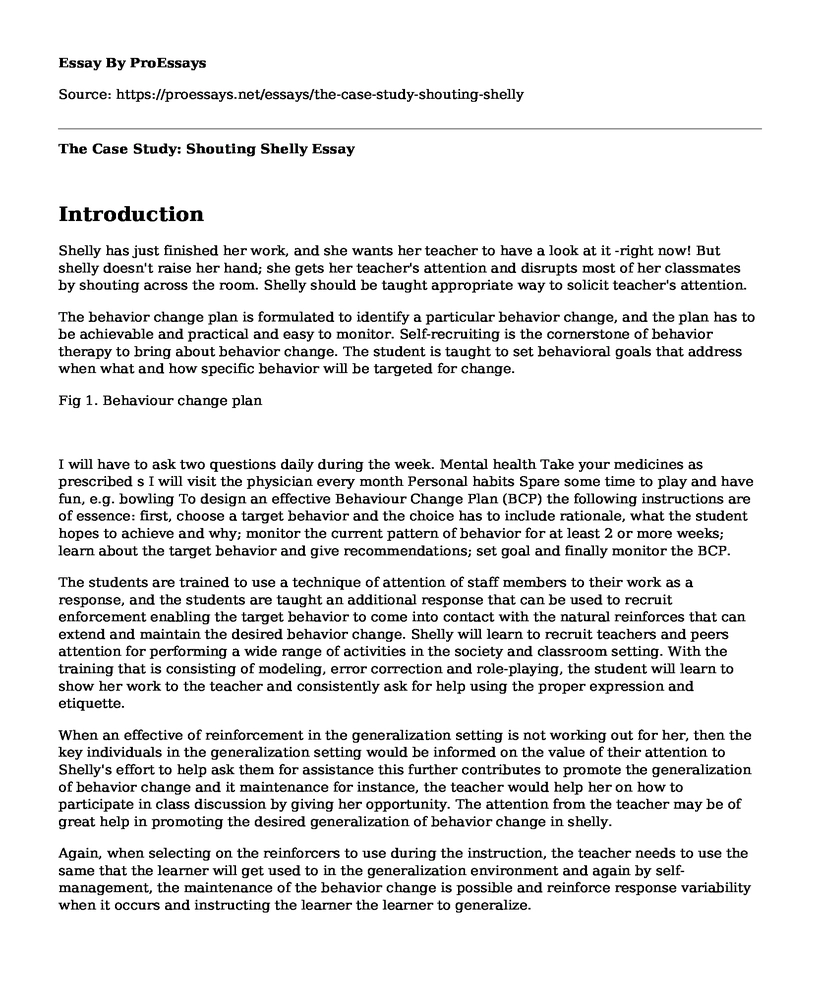Introduction
Shelly has just finished her work, and she wants her teacher to have a look at it -right now! But shelly doesn't raise her hand; she gets her teacher's attention and disrupts most of her classmates by shouting across the room. Shelly should be taught appropriate way to solicit teacher's attention.
The behavior change plan is formulated to identify a particular behavior change, and the plan has to be achievable and practical and easy to monitor. Self-recruiting is the cornerstone of behavior therapy to bring about behavior change. The student is taught to set behavioral goals that address when what and how specific behavior will be targeted for change.
Fig 1. Behaviour change plan
I will have to ask two questions daily during the week. Mental health Take your medicines as prescribed s I will visit the physician every month Personal habits Spare some time to play and have fun, e.g. bowling To design an effective Behaviour Change Plan (BCP) the following instructions are of essence: first, choose a target behavior and the choice has to include rationale, what the student hopes to achieve and why; monitor the current pattern of behavior for at least 2 or more weeks; learn about the target behavior and give recommendations; set goal and finally monitor the BCP.
The students are trained to use a technique of attention of staff members to their work as a response, and the students are taught an additional response that can be used to recruit enforcement enabling the target behavior to come into contact with the natural reinforces that can extend and maintain the desired behavior change. Shelly will learn to recruit teachers and peers attention for performing a wide range of activities in the society and classroom setting. With the training that is consisting of modeling, error correction and role-playing, the student will learn to show her work to the teacher and consistently ask for help using the proper expression and etiquette.
When an effective of reinforcement in the generalization setting is not working out for her, then the key individuals in the generalization setting would be informed on the value of their attention to Shelly's effort to help ask them for assistance this further contributes to promote the generalization of behavior change and it maintenance for instance, the teacher would help her on how to participate in class discussion by giving her opportunity. The attention from the teacher may be of great help in promoting the desired generalization of behavior change in shelly.
Again, when selecting on the reinforcers to use during the instruction, the teacher needs to use the same that the learner will get used to in the generalization environment and again by self-management, the maintenance of the behavior change is possible and reinforce response variability when it occurs and instructing the learner the learner to generalize.
When designing a plan for change, the teacher should not teach only one good example good examples and expect the students to generalize from that example by teaching sufficient stimuli example and hoe to respond to them. The termination part should be made to ensure that the students can still maintain the behavior change. When designing the plan of adjustment, all the students should be put into consideration with each student capability including the disabled. The practice should be in line with the law of the land, for instance, child registration and health details have to be very confidential and private.
Conclusion
Many techniques are used in the generalization and maintenance of behavior change, for instance, used of multiple peer exemplars to develop generalized social responding and use of the non-handicapped peers to increase the rate of social interactions, for example, Shelly tends to be dominant in class and relatively rude. Additionally, the numerous baseline designs conclusively show generalization on treatment conditions or the settings. To obtain the generalization and to maintain the behavior change, practical design has to be chosen that can make it possible for the measurement of the generalization. The signs, variables and the subjects may be varied in several ways depending on the experts 'preference for instance, across settings or across peers and environments. However, the design allows one to identify whether the successive introduction of the intervention phase possibly generalized across peers or the social interactions is enhanced in the generalization setting.
Reference
Cooper, J. O., Heron, T. E., & Heward, W. L. (2007). Applied behavior analysis.
Cite this page
The Case Study: Shouting Shelly. (2022, Aug 15). Retrieved from https://proessays.net/essays/the-case-study-shouting-shelly
If you are the original author of this essay and no longer wish to have it published on the ProEssays website, please click below to request its removal:
- Time-space Constraints and Depression in Education
- Information Hand-Out on Depression in Older Adults
- Behavior and Mental Status: NBC News on Disruptive Mood Dysregulation Disorder
- Communication Strategy Campaign for Patients With Post-traumatic Stress Disorder (PTSD) - Essay Sample
- Essay Example on Artist Sam Gilliam's Mental Health Fight: A Case Study
- Annotated Bibliography Paper Example on Multicultural Counselling: Best Practices for Change
- Stress Management: Effective Techniques to Cope and Deal - Essay Sample







